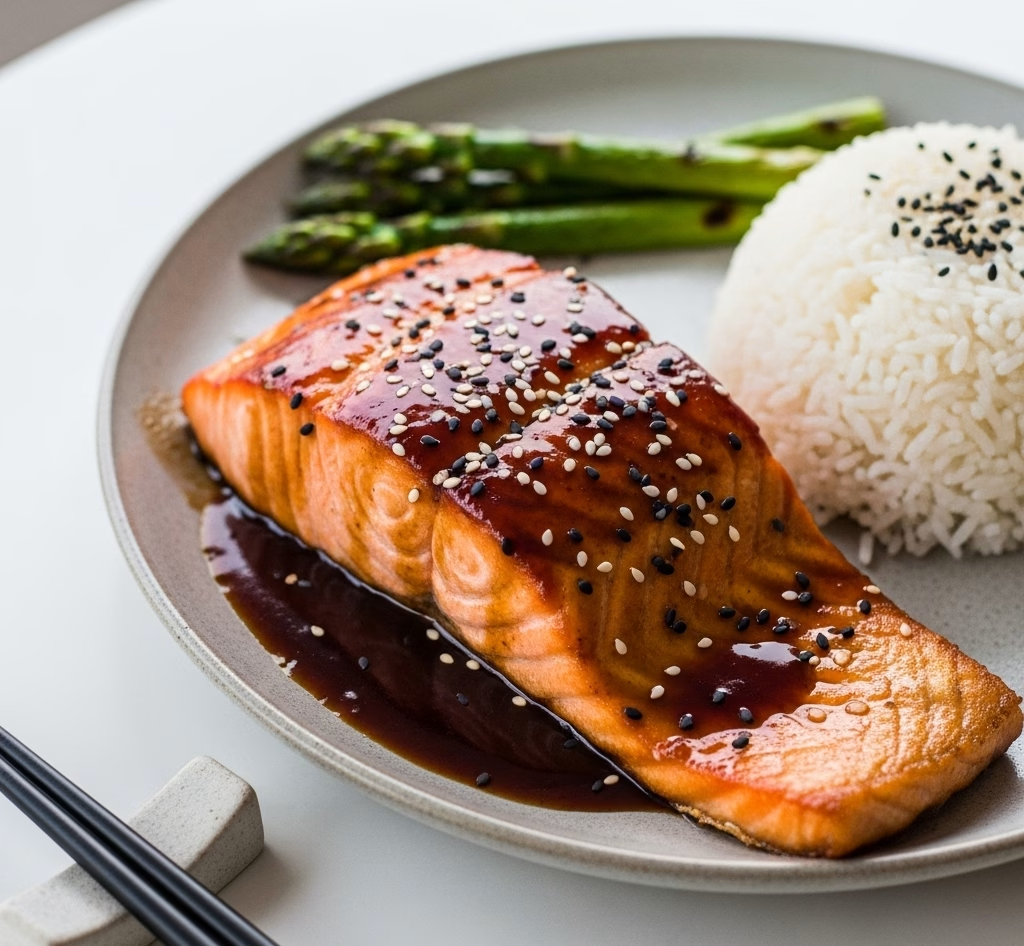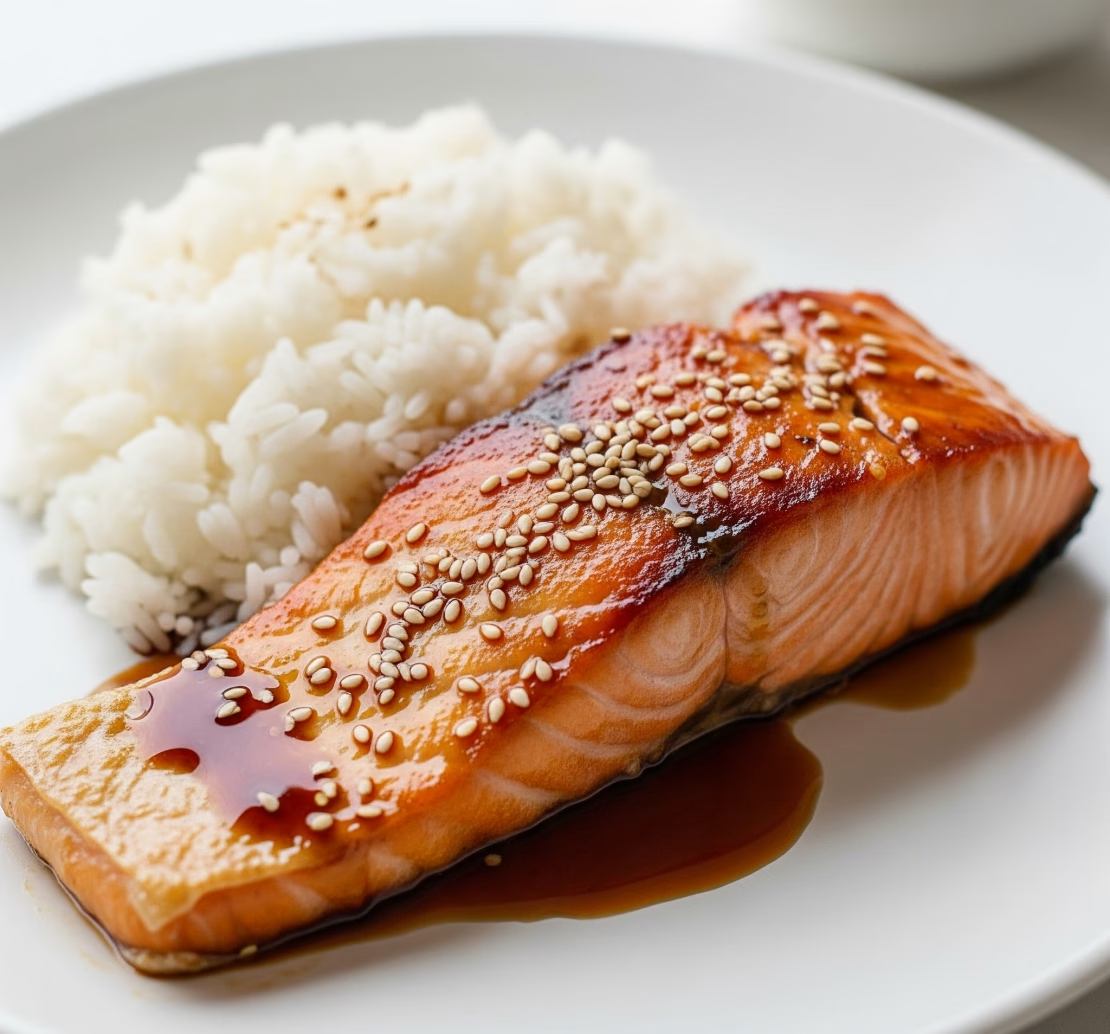Salmon Teriyaki is a beautifully balanced dish that showcases the sweet-savory essence of traditional Japanese teriyaki sauce paired with the rich, buttery texture of perfectly seared or grilled salmon.
Revered for its simplicity, elegance, and depth of flavor, this dish is a staple both in Japanese households and restaurants around the world. Its glossy glaze, crisp edges, and moist interior make it a satisfying option for weeknight meals or special occasions alike.
Served over a bowl of steamed rice with a side of vegetables or pickles, Salmon Teriyaki is an enduring favorite that exemplifies Japanese culinary harmony.
Table of Contents
Ingredients
For the Salmon:
- 2 fresh salmon fillets (skin-on, about 6 oz/170g each)
- ½ teaspoon salt
- ½ teaspoon freshly ground black pepper
- 1 tablespoon vegetable oil (for searing)
For the Teriyaki Sauce:
- ¼ cup soy sauce (preferably Japanese-style)
- 2 tablespoons mirin (sweet rice wine)
- 2 tablespoons sake (or dry white wine)
- 1 tablespoon brown sugar (or honey for variation)
- 1 teaspoon grated ginger (optional)
- 1 teaspoon minced garlic (optional, non-traditional)
For Garnish and Serving:
- Toasted sesame seeds
- Chopped green onions or scallions
- Steamed Japanese rice (short grain)
- Pickled vegetables or lightly sautéed greens (bok choy, spinach)
Serves
2 people as a main dish
Step-by-Step Instructions
1. Prepare the Sauce
- In a small saucepan, combine soy sauce, mirin, sake, and brown sugar.
- Stir over medium heat until sugar dissolves.
- Let it simmer for 3–4 minutes until slightly thickened.
- For a modern twist, add ginger and garlic, though traditional teriyaki is often made without them.
2. Prepare the Salmon
- Pat the salmon fillets dry with paper towels to ensure even browning.
- Season lightly with salt and pepper.
- Let rest at room temperature for about 10 minutes to prevent curling in the pan.
3. Sear the Salmon
- Heat a non-stick or cast-iron skillet over medium-high heat.
- Add vegetable oil.
- Place the salmon fillets skin-side down and cook for about 4–5 minutes until the skin is crisp and the fish is nearly cooked through.
- Flip carefully and cook the other side for 2–3 minutes.
4. Glaze the Salmon
- Reduce heat to medium-low.
- Pour the teriyaki sauce into the skillet with the salmon.
- Spoon the sauce over the fillets as it reduces further, about 2–3 more minutes.
- The sauce will become syrupy and coat the salmon evenly.
5. Serve
- Transfer the salmon to plates and drizzle with extra sauce.
- Garnish with sesame seeds and chopped green onions.
- Serve immediately with steamed rice and your choice of sides.
Serving Suggestions
- Classic Pairing – Serve with sticky Japanese rice and a side of miso soup.
- Bento Style – Add tamagoyaki (rolled omelet), pickled ginger, and sautéed greens.
- Rice Bowl (Donburi) – Place the glazed salmon over a bowl of rice with avocado slices, nori strips, and a soft-boiled egg.
- With Noodles – Serve over soba or udon noodles with stir-fried vegetables.
- Light Option – Pair with a crisp cucumber or wakame seaweed salad.
Tips for Perfect Salmon Teriyaki
- Use Skin-On Salmon – The skin crisps beautifully and helps hold the fillet together.
- Don’t Overcook the Sauce – Teriyaki sauce thickens quickly; remove it before it turns too sticky or burns.
- Let the Fish Rest Before Cooking – Avoids curling and ensures even searing.
- Use Authentic Japanese Ingredients – Japanese soy sauce, mirin, and sake make a big difference in authenticity.
- Sear, Then Glaze – Searing the salmon first locks in flavor and provides texture.
Healthier Alternatives
- Use Low-Sodium Soy Sauce – Reduces overall sodium content.
- Substitute with Coconut Aminos – Great gluten-free and soy-free alternative.
- Bake Instead of Frying – Bake salmon at 400°F (200°C) for 12–15 minutes, then glaze with sauce.
- Use Less Sugar – Cut sugar by half or substitute with honey or maple syrup.
- Pair with Brown Rice or Cauliflower Rice – Adds fiber and lowers carbs.
Creative Variations
- Spicy Teriyaki Salmon – Add a touch of sriracha or chili flakes to the sauce.
- Teriyaki Salmon Sushi Rolls – Flake the cooked salmon and roll into sushi with avocado and cucumber.
- Teriyaki Salmon Tacos – Wrap pieces in a tortilla with cabbage slaw and wasabi mayo.
- Grilled Teriyaki Salmon Skewers – Cube salmon, skewer with bell peppers, and grill with glaze.
- Teriyaki Salmon Salad – Serve flaked salmon over mixed greens with sesame dressing.
Common Mistakes to Avoid
- Boiling the Sauce Too Long – It can reduce too much and become bitter.
- Not Drying the Salmon – Moisture prevents browning and crisp skin.
- Overcrowding the Pan – Causes steaming instead of searing.
- Using Inferior Soy Sauce – Choose high-quality Japanese soy sauce for the right flavor.
- Skipping Mirin or Sake – These provide crucial sweetness and umami.
History of Salmon Teriyaki
Teriyaki as a cooking method originates from Japan and combines two words: “teri” (shine or luster) and “yaki” (grill or broil). The name refers to the glossy sheen that develops on foods coated with a soy sauce-based glaze. Historically, teriyaki began as a method for preserving and flavoring fish, particularly in regions where fresh ingredients were seasonal or hard to come by.

The traditional method used fish such as yellowtail, mackerel, or eel. However, salmon gained popularity in teriyaki dishes more recently, particularly after World War II. As Japanese cuisine spread globally and salmon became widely available, it naturally became a star protein for this technique due to its rich, fatty texture that pairs well with the umami glaze.
In modern times, Salmon Teriyaki is one of the most common variations of this ancient method, enjoyed across Japan and in Japanese restaurants around the world. The dish strikes a perfect balance between traditional cooking and modern adaptation, making it both classic and contemporary.
FAQs about Salmon Teriyaki (Japan)
1. What is the difference between teriyaki sauce and soy sauce?
Soy sauce is a single ingredient, while teriyaki sauce is a mixture of soy sauce, mirin, sake, and sugar for a sweet-savory glaze.
2. Can I use store-bought teriyaki sauce?
Yes, but making your own allows for better flavor control and authenticity.
3. Can I grill the salmon instead of pan-searing it?
Absolutely. Grill skin-side down over medium heat and brush with sauce in the final minutes.
4. Is Salmon Teriyaki gluten-free?
Not typically, but you can use gluten-free soy sauce (tamari) and check your mirin and sake labels.
5. What other fish can be used?
Yellowtail, cod, halibut, or trout work well with teriyaki sauce.
6. Can I use frozen salmon?
Yes, just ensure it’s fully thawed and patted dry before cooking.
7. How do I know when salmon is done?
It should flake easily and be opaque in the center, usually at an internal temperature of 125–130°F (52–54°C).
8. Can I meal-prep this dish?
Yes. Cooked salmon teriyaki keeps well in the fridge for up to 3 days and reheats nicely.
9. Is teriyaki sauce vegan?
Not always. Mirin and sake are vegan, but check soy sauce for additives. Also, skip fish-based sauces.
10. Can I bake the salmon with the teriyaki sauce?
Yes, but add the sauce in the last few minutes or brush it on after baking to prevent burning.
Salmon Teriyaki (Japan) captures the heart of Japanese home cooking—simple, elegant, and bursting with umami. With its rich yet balanced flavors and inviting presentation, this dish is a staple for good reason. Whether served in a bento box, over a rice bowl, or as a dinner centerpiece, it’s a meal that delivers comfort and class in equal measure. By mastering this dish, you not only embrace a key aspect of Japanese cuisine but also unlock a go-to recipe that never fails to impress.


